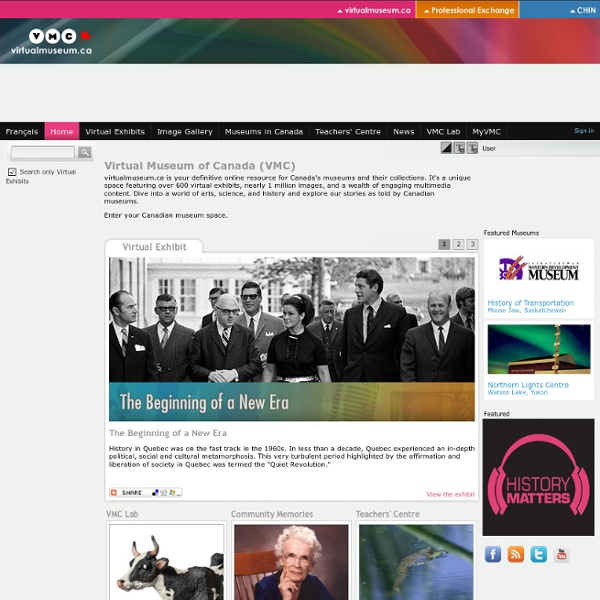



NOTCOT.ORG Quebec Museums Historical Thinking | The Historical Thinking Project Digital Archives - lesson-plan - What Is Canada's Constitution? Subjects: History, Social Studies, Political Science Purpose: To explore the history and importance of Canada’s Constitution and the Charter of Rights, to gather information from an online resource Summary: In this introductory activity, students explore the history and relevance of Canada’s 1982 Constitution and Charter of Rights. Before Exploring Brainstorm with students what they know about Canada's Constitution and Charter of Rights. Outline the Opportunity Direct students to the topic Charting the Future: Canada's New Constitution on the CBC Digital Archives website. Write the following statement on the board: The patriation of the Constitution with the Charter of Rights in 1982 marked a decisive turning point in Canadians' national identity and their pursuit of equality. Revisit and Reflect Ask: How have the patriation of the Constitution and the enactment of the Charter of Rights affected your lives? Extension
100 curators, 100 days on Saatchi Online Saatchi Online has launched a new initiative where 100 curators each select works by ten of the 60,000 artists exhibiting on the website, revealing their choices over the next 100 days... Saatchi Online launched in 2006 with the aim of providing exposure for artists without gallery representation, and as a means for them to sell their work (with Saatchi's taking a commission on each sale). To date the online gallery has over 60,000 artists on its site representing a wide range of disciplines and media. From this huge collection the curators have chosen ten pieces of work each, and each choice of ten will be revealed over the next three months. The curators themselves hail from all over the world and include Alessandro Vincentelli, Baltic Centre for Contemporary Art, Gateshead; Daria de Beauvais, Palais de Tokyo, Paris; John Zarobell, MoMA, San Francisco; Peter MacGill, Pace/MacGill Gallery, New York City; and Lara Boubnova, Director of the Institute of Contemporary Art, Sofia.
World Art Treasures Home 100,000 Pictures Europe Austria Czech Republic England France Germany Italy Portugal Romania Spain Switzerland Turkey North Africa Egypt Morocco Far East China India Japan Nepal South-East Asia Burma Indonesia American's Art Museums Artists Altdorfer Albrecht Angelico Fra Biéler Ernest Bernini Gian Lorenzo Blake William Böcklin Arnold Bosch Hieronymus Botticelli Bronzino Canaletto Canova Antonio Carpaccio Vittore Cimabue Caravaggio Chardin Jean-Siméon Crivelli Carlo David Jacques Louis Delacroix Eugène Donatello Duccio di Buonisegna Dürer Eyck Jan van Fragonard Jean-Honoré Friedrich Caspar David Füssli Johann Heinrich Ghirlandaio Domenico Giorgione Giotto di Bondone Gleyre Charles Goya y Lucientes Gozzoli Benozzo El Greco Grünewald Matthias Hogarth William Holbein the Younger Hans Ingres Jean-Auguste-Dominique Klimt Gustav Ledoux Claude-Nicolas Leonardo da Vinci Limbourg Brothers Liotard Jean-Étienne Longhi Pietro Lotto Lorenzo Manet Edouard Mantegna Andrea Martini Simone Masaccio Memling Hans Menn Barthélemy Michelangelo Moreau Gustave Palladio Andrea Bode
Ontario Museums British Columbia Museums Association - Teaching for Understanding British Columbia’s Heritage Daily life in a Nuu-chah-nulth house, as drawn by John Webber. You have just opened an educational resource of lesson plans that have British Columbia's history as their content and critical thinking as their methodology. This resource is the product of workshops conducted by the "TFU" (Teaching for Understanding) British Columbia Network, which resulted in lesson plans developed by groups of teachers and curators. Curators provided primary source material and historical content and teachers provided the appropriate educational framework and lesson focus. We hope these lesson plans provide you with useful content and exciting ideas to take to your students.
Digital Archives - Charting the Future: Canada's New Constitution - The Constitution and Charter re-evaluated It was a hard-fought coming of age for Canada. From the 1960s through the early 1980s, Canadian politicians argued fiercely at the constitutional bargaining table over the balance of provincial and federal power. In the end, Canada gained a Charter of Rights and Freedoms and a homemade Constitution. But it would not be without its costs as the question of Quebec's status in Canada loomed larger than ever. Twenty years after the birth of the Constitution Act in 1982, Canadians are re-evaluating its worth and power. • From 1982 to 2002, the Supreme Court struck down more than 70 laws thanks to the Charter.Some of the landmark cases include:• Morgentaler, Jan. 28, 1988; Canada's abortion law was deemed unconstitutional on the basis that it violated a woman's right to "life, liberty and security of person." • Vriend, April 2, 1998; a unanimous ruling that Alberta failed to "extend protection to homosexuals" in its Human Rights Act. • "It has transformed the psyche of Canadians.